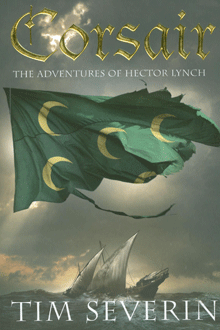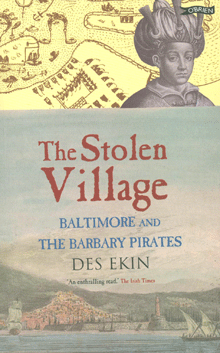Barbary pirates in Ireland: The Sack of Baltimore, Co. Cork

Turkish Ottoman Empire , Ireland, Algiers, Barbary, slavery
 The harbour side village of Baltimore in the south-west of Ireland is a favourite port of call for fishermen and yachtsmen because of its sheltered position behind Sherkin Island. Its location is of great interest to the artist, antiquary and naturalist. In McCarthy’s, one of its quayside pubs, a wall chart testifies to the marine mayhem that took place over the centuries in nearby Roaringwater Bay.
The harbour side village of Baltimore in the south-west of Ireland is a favourite port of call for fishermen and yachtsmen because of its sheltered position behind Sherkin Island. Its location is of great interest to the artist, antiquary and naturalist. In McCarthy’s, one of its quayside pubs, a wall chart testifies to the marine mayhem that took place over the centuries in nearby Roaringwater Bay.
Situated in the barony of Carberry, in South Munster, the village grew up round a sixteenth century Castle of 0’Driscoll and, after his ruin, the place was colonized by the English. Around 1600 a defeat was inflicted on these local warlords when “several ships of the 0’Driscoll fleet sank in an affray with a fleet from Waterford” within sight of the 0’Driscoll stronghold towering above the village. In 1620 a Spanish galleon was sunk offshore.
Baltimore saga
A much stranger misfortune befell in 1631 when pirates from Algiers and armed troops of the Turkish Ottoman Empire stormed ashore at the little harbour village of Baltimore. In an era when it was common place for white traders from England to land on the African coast and to seize black people as slaves, this was one of the comparatively rare occasions when the boot was on the other foot.
A massacre took place when two Algerian galleys landed in the dead of night, sacked the town and bore off into slavery mostly women and children: altogether fifty youngsters ‘even those in the cradle’ were abducted, along with thirty-four women and nearly two dozen men, principally the descendants of dissenting and peaceful Protestant settlers from Cornwall, Somerset and Devon.
The invasion left King Charles I (reign 1625-49) incandescent with rage and provoked him into a reaction extreme enough to help create a revolution in England. Recognised at the time as an unprecedented act of aggression by the Islamist empire, Des Ekin’s recent book, The Stolen Village, is described as … a fascinating exploration of a forgotten chapter of British and European history.
The Sack of Baltimore
In 1631 a particularly brazen Barbary corsair was operating from Sallee on the Atlantic coast of Morocco. A sea captain from Flanders, he had ‘turned Turk’ and taken the name Morat Rais. That year, with two ships, on the night of 20 June 1631 this corsair chieftain made a surprise raid on the Irish coastal village of Baltimore successfully kidnapping most of its population of men, women and children. Their fate was to be sold into slavery on the Barbary Coast of North Africa. A French missionary priest working in Algiers saw several of Morat’s Irish captives put up for auction. After that, very little more was heard of them.
The pirates were steered up the intricate channel by a Dungarvan fisherman whom they had taken at sea for the purpose. Two years later he was convicted and executed for the crime.
The Sack of Baltimore by Thomas Osborne Davis (1814-1845), Irish patriot, poet and politician, is a vivid description in poetry of the raid by Algerian pirates in 1631. Its verses are in a book of Davis’s Poems Dublin: published by James Duffy, 1846. Born in Mallow, Co. Cork, son of an army surgeon, Davis was educated at Trinity College Dublin and called to the bar in 1838. He became the unofficial leader of the Young Ireland movement and jointly founded the Irish newspaper Nation (1842). He died prematurely in Dublin from scarlet fever on 16 September 1845 aged thirty-one. His funeral was a major public event.
 Journalist and writer, Des Ekin’s book The Stolen Village: Baltimore and the Barbary Pirates (pp.398) provides the wider historical, political and social context at the time of the raid with fascinating detail about what happened and what followed. From a variety of historical, academic, political, legal and social archives many of the pictures and written sources are recorded in original documents, reports and letters of the period; the personal reminiscences of slaves in Algiers; and some histories written during the Barbary era. Ekin’s book prints these lines of Davis’s poem (1844) conveying the panic and terror of the raid.
Journalist and writer, Des Ekin’s book The Stolen Village: Baltimore and the Barbary Pirates (pp.398) provides the wider historical, political and social context at the time of the raid with fascinating detail about what happened and what followed. From a variety of historical, academic, political, legal and social archives many of the pictures and written sources are recorded in original documents, reports and letters of the period; the personal reminiscences of slaves in Algiers; and some histories written during the Barbary era. Ekin’s book prints these lines of Davis’s poem (1844) conveying the panic and terror of the raid.
A stifled gasp! A dreamy noise, ‘The roof is in a flame!’
From out their beds, and to their doors, rush maid and sire
and dame.
And meet, upon the threshold stone, the gleaming sabres fall,
And over each black and bearded face the white and
crimson shawl.
The yell of ‘Allah’ breaks above the prayer and shriek and roar
Oh, blessed God! The Algerine is Lord of Baltimore.
The prisoners were destined for a variety of fates - some would live out their days chained to the oars as galley slaves, while others would spend long years in the scented seclusion of the harem or within the walls of the Sultan’s palace. The old city of Algiers, with its narrow streets, intense heat and lively trade, was a melting pot where the villagers would join slaves and freemen of many nationalities. Only two of them ever saw Ireland again.
Tim Severin’s latest book Corsair: The Adventures of Hector Lynch (pp. 346) is about the fictional adventures of a seventeen year old boy who, with his sister, was snatched from an Irish village by Barbary corsairs and sold at auction in Algiers. Befriended by fellow captive Dan, a Miskito Indian from the Caribbean, he finds himself in a bewildering world where life is cheap and only the quick-witted survive. The book traces Hector’s search to find his long lost sister.
The story introduces a cast of ferocious historical characters, including pickpockets and sadistic sea officers, venal merchants and cultured Turkish sea captains, a power-crazed sultan and fanatical member of the Knightly Orders. Their violent, treacherous and sometimes gallant deeds take place against a meticulously researched backdrop extending from the kasbahs of North Africa to the sands of the Sahara.
Historical Note
Barbary describes a region in North Africa stretching from Egypt to the Atlantic Ocean that is named after the Berbers. In ancient times it consisted of Mauritania, Numidia, Africa, Propria, and Cyrenaica. It was successively conquered by Romans, Vandals, Arabs, Turks, Spaniards, French, and Italians.
Between the sixteenth and eighteenth centuries, Barbary was notorious for its pirates who plagued the Mediterranean and its Atlantic approaches. Slavery in various guises was flourishing on all sides of the Mediterranean. Barbary corsairs thrived against a general background of the Eternal War between Cross and Crescent and struggles amongst European nations for power.
The Regencies of Tunis, Algiers and Tripoli were infamous in the Christian world as places where the unfortunate captives were either set to work or held for ransom. Yet there were also thriving slave markets in Malta and Livorno where Muslims - and sometimes non-Muslim as well - were bought and sold. The Knights of St John of Malta were at the forefront of the trade in much the same way that the corsair guilds in the Regencies, the taifas, were the chief providers of human merchandise in North Africa.
Traveller’s Note
The quotation is credited to Memoirs of the Lady Hester Stanhope, 1845. ‘I have discovered the origin of the Irish as well as that of the Scotch. The Irish are from a tribe of Arabs, the most distinguished in the desert, whose women, for many thousand years have been famous for their beauty, and the men likewise for their strong attachments’.
If true, it is another dimension to this fascinating true story of Irish slaves, Barbary pirates, exotic lands and political intrigue.
 Ita Marguet, January 2008
Ita Marguet, January 2008
Note: Acknowledgement is given to all sources used in preparation of this article. It follows published texts on Journey to Morocco: Irish historical and cultural legacy (May 2007) and Berbers and Irish Language: Historical Accounts (October 2007) by Ita Marguet.


